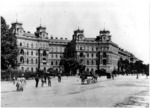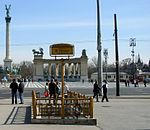Epreskert Art Colony
19th century in Hungary19th century in art20th century in Hungary20th century in artEuropean artist groups and collectives ... and 2 more
Hungarian artNeighbourhoods of Budapest

Epreskert Art Colony (Hungarian: Epreskerti művésztelep; the name means "Mulberry Garden" in Hungarian) was an artists' colony in Budapest in the last decades of the 19th and the first half of the 20th century. Among the artists who worked and lived there the most important were sculptors György Zala and Adolf Huszár, and painter Árpád Feszty.
Excerpt from the Wikipedia article Epreskert Art Colony (License: CC BY-SA 3.0, Authors, Images).Epreskert Art Colony
Munkácsy Mihály utca, Budapest Terézváros
Geographical coordinates (GPS) Address Nearby Places Show on map
Geographical coordinates (GPS)
| Latitude | Longitude |
|---|---|
| N 47.513 ° | E 19.072 ° |
Address
Diplomataház
Munkácsy Mihály utca 14
1063 Budapest, Terézváros
Hungary
Open on Google Maps








